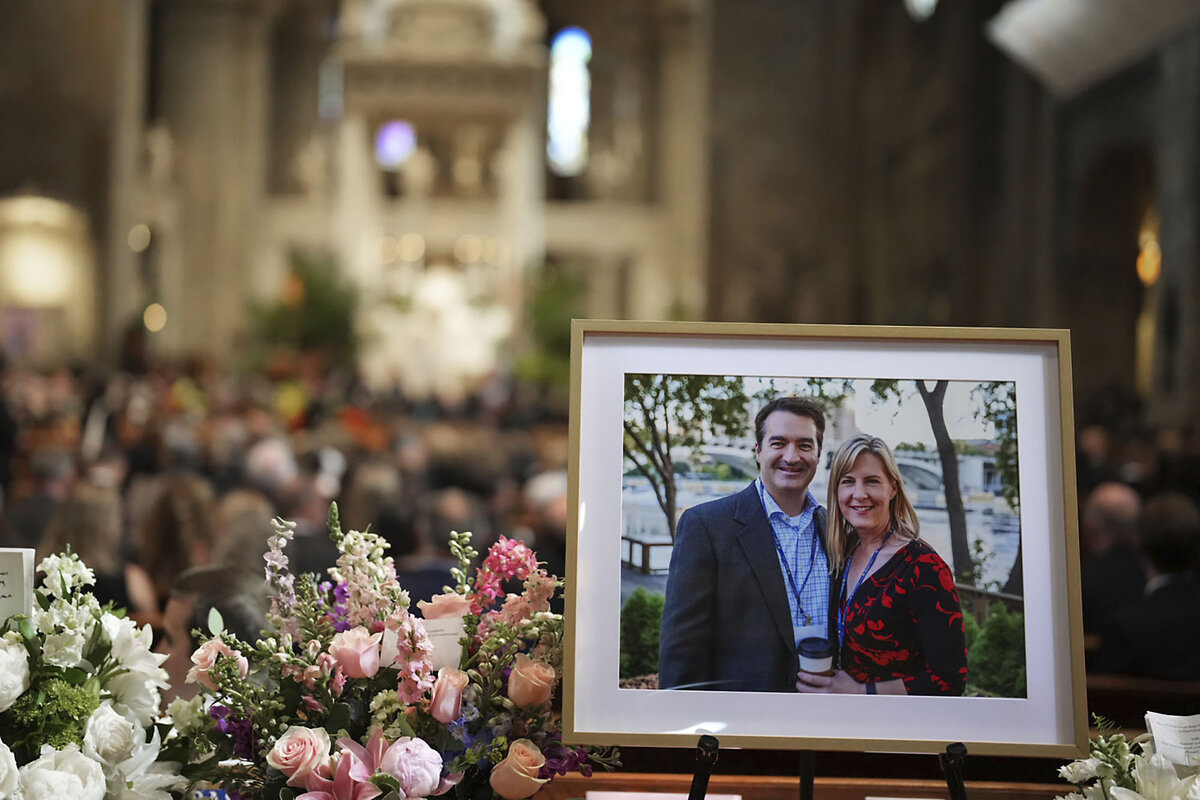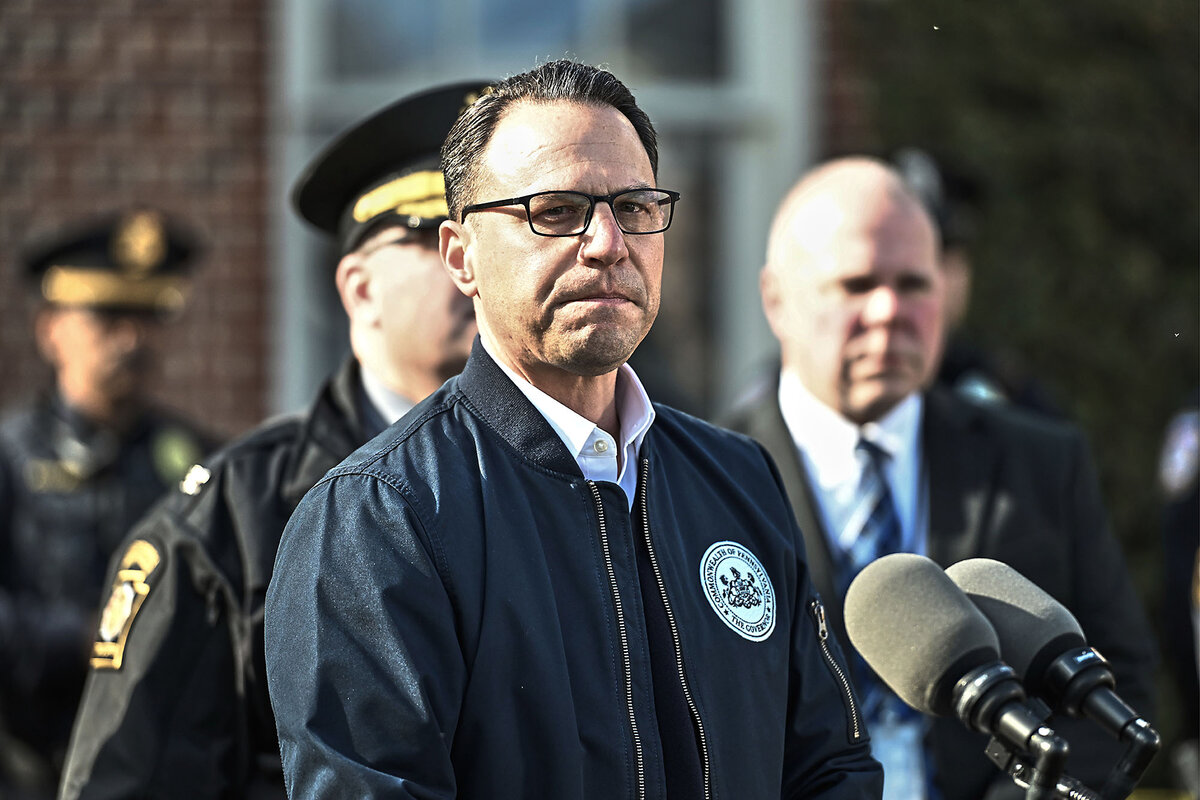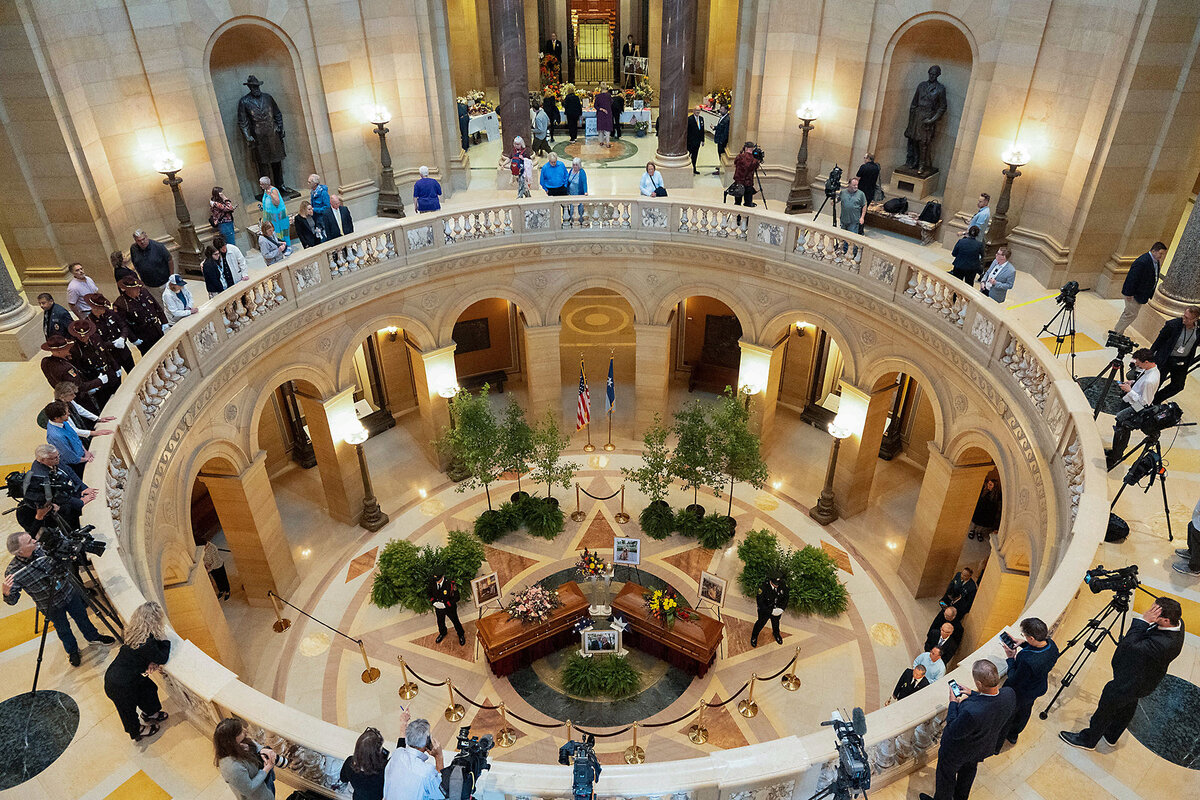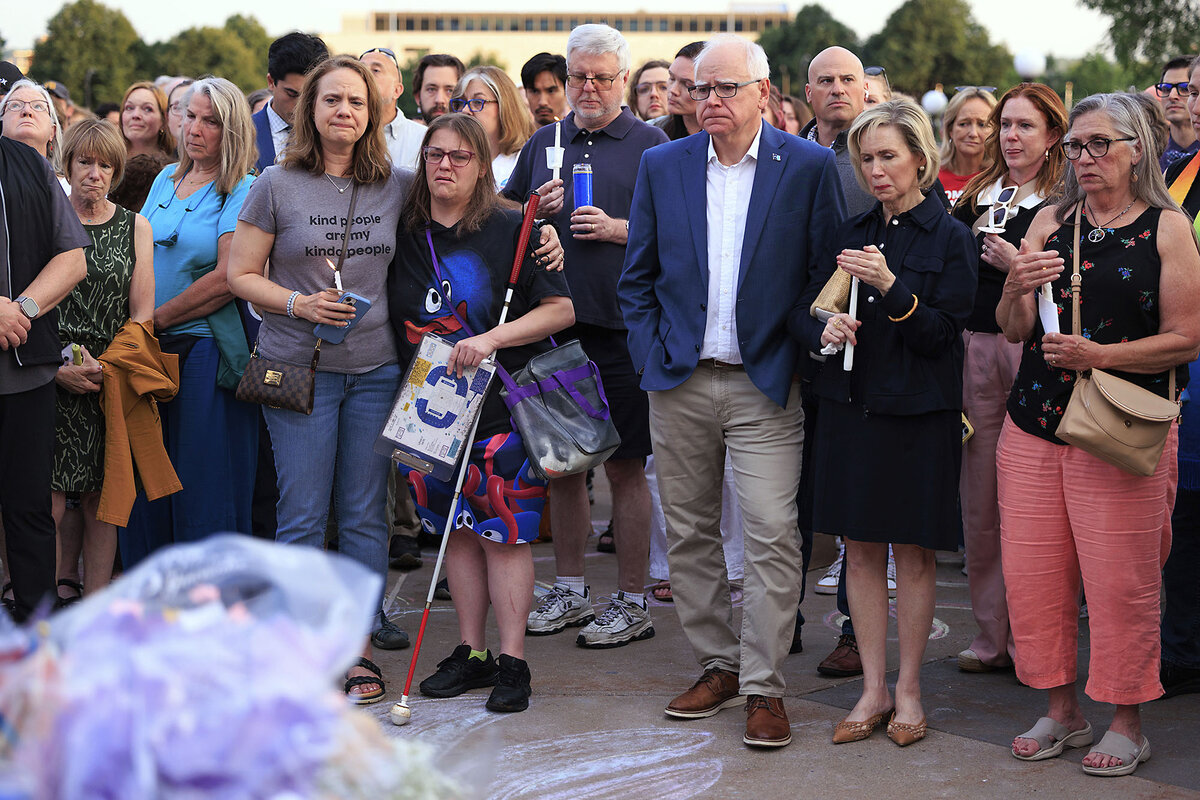In aftermath of Minnesota shootings, tracking a disturbing rise in political violence
Loading...
| St. Paul, Minn.
Two weeks after a gunman killed Democratic state lawmaker Melissa Hortman and her husband, Mark, at their home, thousands of Minnesotans lined up at the state Capitol to pay their respects.
Many praised Ms. Hortman, a former House speaker, and expressed horror that such a brazen act could happen in a state that prides itself on civic engagement and open government. Others, though, seemed grimly unsurprised that a national tide of scorched-earth politics and extremism had crashed into Minnesota.
ŌĆ£We live in a society that demonizes [public officials],ŌĆØ says Kristofer Scheide, a university employee waiting in line outside the rotunda. His mother was a state lawmaker, he says, and he has seen the toll on those in public life.
Why We Wrote This
Experts warn of an era of ŌĆ£normalized violence,ŌĆØ in which politically motivated attacks are upending norms and heightening the risks of public service. ItŌĆÖs impacting not only national politicians but also state and local officials ŌĆō who are increasingly being attacked at their homes.
Across the country, is upending norms of democracy and heightening the risks of public service for officials from presidential candidates to Supreme Court justices, state lawmakers to local politicians. In the weeks just since the June 14 shootings in Minnesota, in which another state lawmaker and his wife were also critically wounded, a Memphis man was charged with attempted kidnapping after police said he┬Ā, while Ohio Rep. Max Miller and said he wanted to kill him. Earlier this year, a Pennsylvania man was after a nighttime attack on Gov. Josh ShapiroŌĆÖs house that forced him and his family to flee.
Many compare the current period to the late 1960s and early 1970s, another tumultuous time that saw numerous bombings and several high-profile assassinations. Last summer, President Donald Trump survived two alleged assassination attempts, including one in which a bullet nicked his ear and a rallygoer was shot and killed.
But experts say the current wave of political violence is distinct in several ways. While the violence in the 1960s and ŌĆÖ70s was perpetrated mostly by those with left-wing views, todayŌĆÖs attacks are more often committed by right-wing extremists or people with incoherent ideological beliefs. And it isnŌĆÖt just national figures, but relatively unknown state and local officials being attacked ŌĆō often in their homes.
ŌĆ£We seem to be witnessing a growing phenomenon in which politicians are actually being targeted not at work and not in public places, but in their homes, and I think thatŌĆÖs a very concerning development,ŌĆØ says Jacob Ware, a research fellow at the Council on Foreign Relations who studies terrorism and extremism.
The public response is also different. While previous periods of political violence sparked widespread shock and outrage that often led to reforms, the reaction today seems more muted.
Some Americans even appear to condone political violence. 29% of Republicans agreed that ŌĆ£true American patriotsŌĆØ may need to use violence to save the country ŌĆ£because things have gotten so far off track.ŌĆØ Since the 2024 election, similar beliefs have surged on the left. A survey in May by the Chicago Project on Security and Threats found that 40% of Democrats would support the use of force to remove Mr. Trump from office,
Such attitudes reflect a general erosion of norms, says Mr. Ware. He and others point to a general coarsening of political rhetoric, and a tendency to frame policy disputes in existential terms. And as violent events increase, each one seems less shocking. Just as school shootings have become numbingly routine, incidents like the shootings of lawmakers in Minnesota move out of the news cycle in a matter of days.
ŌĆ£It feels like the culture has shifted, and weŌĆÖve entered an era of normalized violence,ŌĆØ Mr. Ware says.
ŌĆ£Targeted political assassinationsŌĆØ
On the same day that the Hortmans lay in state at the Capitol, a man wearing a padded green smock, held together by Velcro, and rubber-soled orange slip-ons was led inside a federal courtroom a mile away. It was the second courtroom appearance for Vance Boelter, a Minnesota father of five charged in connection with the shootings.
, driving a black Ford SUV with fake plates and flashing lights in the early hours of June 14 to the suburban homes of multiple state lawmakers, and wearing body armor and a face mask. Before murdering the Hortmans, they allege, he also shot and critically wounded state Sen. John Hoffman and his wife, Yvette, who had opened the door to him. He was arrested after a massive manhunt and faces multiple counts of murder, stalking, and firearm offenses.
Joe Thompson, acting U.S. attorney for the District of Minnesota, said Mr. Boelter committed ŌĆ£targeted political assassinations.ŌĆØ
Police recovered guns and ammunition from Mr. BoelterŌĆÖs SUV, along with notebooks containing the names and home addresses of dozens of elected officials. ; they included Minnesota Gov. Tim Walz, Sen. Tina Smith, and state Attorney General Keith Ellison, as well as the names of abortion providers and abortion-rights activists.
Prosecutors havenŌĆÖt spoken publicly about Mr. BoelterŌĆÖs motivations. and was , including in Africa. Friends have told reporters that he was volatile and had struggled to find stable work. Before being captured by authorities, Mr. Boelter texted his family, ŌĆ£Dad went to war last night,ŌĆØ .
Far-right extremists have accounted for in the United States in recent years, by far-left and Islamic extremists. But while Mr. BoelterŌĆÖs targets and reported beliefs suggest right-wing extremism, analysts caution that itŌĆÖs often hard to draw a straight line from political beliefs to a violent act, and that law enforcement is finding more cases in which violence seems motivated more by nihilism.
The alleged Minnesota shooter ŌĆ£might be somebody who just does not have a coherent ideology,ŌĆØ says Mr. Ware.
A point of contention in Mr. BoelterŌĆÖs June 27 hearing was his padded green smock, a type of anti-suicide dress worn without undergarments. His lawyer asked that her client be permitted to wear regular prison clothing, which the judge agreed to. Asked for his response, Mr. Boelter told the court, ŌĆ£IŌĆÖve never been suicidal, and IŌĆÖm not suicidal now.ŌĆØ
Some perpetrators of political violence do take their own lives, or seek to die at the hands of law enforcement, say terrorism analysts. Others prefer to be captured and stand trial in order to gain a platform to justify their acts.
In a subsequent July 3 court appearance, Mr. Boelter waived his right to detention and probable cause hearings, indicating he wanted the case to proceed to trial. ŌĆ£IŌĆÖm looking forward to the truth and facts about [June] 14th to come to the public and before you and especially what happened before the 14th,ŌĆØ Mr. Boelter told the judge.
Toxic partisanship, harsh rhetoric
Experts on political violence say public officials can help deescalate tensions by condemning violence and supporting peaceful democratic expression. To be more effective, politicians should issue joint statements and make appearances with their political opponents, they say.
Following the June 14 attacks, MinnesotaŌĆÖs congressional delegation, made up of six Democrats and four Republicans, issued a joint statement. And the U.S. House ┬Āand honoring the state lawmakers.
President Trump criticized the violence as well, but didnŌĆÖt reach out to Mr. Walz, the Democratic vice presidential nominee in 2024. Asked later why he hadnŌĆÖt called the Minnesota governor, ┬ĀŌĆ£The guy doesnŌĆÖt have a clue. HeŌĆÖs a mess. So, you know, I could be nice and call him, but why waste time?ŌĆØ
Some experts point to the increasing use of political language that dehumanizes opponents and depicts them as un-American as contributing to a tinderbox environment. When George Wallace, a segregationist Southerner, ran for president in 1968, his blood-and-soil rhetoric was condemned by other candidates as a form of extremism, says Kevin Boyle, a historian at Northwestern University and author of ŌĆ£The Shattering: America in the 1960s.ŌĆØ By contrast, Mr. TrumpŌĆÖs blunt denigration of his opponents has become the everyday language of his administration, and is being imitated by other politicians, including opponents.
That impacts the public, too ŌĆō raising the bar for what people consider shocking or unacceptable.
ŌĆ£The level of shock and opposition to political violence in the ŌĆÖ60s was very, very high. This was not the way that people imagined that they or other people should settle their political differences,ŌĆØ Professor Boyle says.
At the Minnesota Capitol, some expressed at least tentative hope that the HortmansŌĆÖ killings could spur some kind of national reckoning.
The line of visitors waiting to pay their respects stretched around the block. At noon, Colin Hortman, the son of the victims, came outside to greet those in line. ŌĆ£IŌĆÖm literally here hugging every person,ŌĆØ he told a gray-bearded man in a veteransŌĆÖ cap as they embraced.
Inside, St. Paul Mayor Melvin Carter voiced his grief at losing his close friends and, in Ms. Hortman, a political ally who worked tirelessly for her community. He shook his head. ŌĆ£It feels like a terrible marker of where we are as a country,ŌĆØ he says.
Later that afternoon, former President Joe Biden made an unannounced visit to the Capitol, where he kneeled beside the coffins. He and former Vice President Kamala Harris were among more than 1,000 attendees of the coupleŌĆÖs funeral held at a Catholic church in Minneapolis. Mr. Walz eulogized Ms. HortmanŌĆÖs service in the legislature, calling her ŌĆ£the most consequential speaker in Minnesota historyŌĆØ as well as a friend and mentor.
The pastor who led the service, the Rev. Daniel Griffith, lamented that the state had become ŌĆ£ground zeroŌĆØ for political violence. He drew a comparison with the 2020 killing of George Floyd in Minneapolis ŌĆō an event that sparked a national conversation about racial injustice and a broader movement to push for change. In the wake of this latest tragedy, he said, he hopes Minnesota could be ŌĆ£a ground zero place for restoration and justice and healing.ŌĆØ








